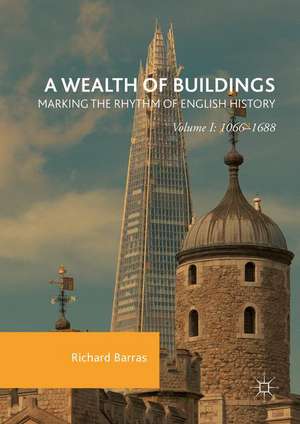A Wealth of Buildings: Marking the Rhythm of English History: Volume I: 1066–1688
Autor Richard Barrasen Limba Engleză Hardback – 19 oct 2016
This first volume provides an introduction to the study of wealth accumulation over the past millennium. There follow three case studies of iconic building investment from the eleventh to the seventeenth century. During the eleventh and twelfth centuries the conquering Norman kings and barons erected castles throughout the country to cement their feudal power. During the thirteenth and fourteenth centuries the great wealth of the ecclesiastical estates funded the lavish construction of Gothic cathedrals and abbeys. During the sixteenth and early seventeenth centuries Tudor and Jacobean magnates vied to build the most magnificent palaces and prodigy houses. The English Revolution brought this era to a close.
| Toate formatele și edițiile | Preț | Express |
|---|---|---|
| Paperback (1) | 644.95 lei 6-8 săpt. | |
| Palgrave Macmillan UK – 27 iun 2018 | 644.95 lei 6-8 săpt. | |
| Hardback (2) | 645.79 lei 6-8 săpt. | |
| Palgrave Macmillan UK – 19 oct 2016 | 645.79 lei 6-8 săpt. | |
| Palgrave Macmillan UK – 5 oct 2016 | 649.06 lei 6-8 săpt. |
Preț: 645.79 lei
Preț vechi: 759.76 lei
-15% Nou
Puncte Express: 969
Preț estimativ în valută:
123.57€ • 129.28$ • 102.65£
123.57€ • 129.28$ • 102.65£
Carte tipărită la comandă
Livrare economică 02-16 aprilie
Preluare comenzi: 021 569.72.76
Specificații
ISBN-13: 9780230360358
ISBN-10: 0230360351
Pagini: 272
Ilustrații: XXVI, 337 p. 48 illus., 16 illus. in color.
Dimensiuni: 148 x 210 x 25 mm
Greutate: 0.57 kg
Ediția:1st ed. 2016
Editura: Palgrave Macmillan UK
Colecția Palgrave Macmillan
Locul publicării:London, United Kingdom
ISBN-10: 0230360351
Pagini: 272
Ilustrații: XXVI, 337 p. 48 illus., 16 illus. in color.
Dimensiuni: 148 x 210 x 25 mm
Greutate: 0.57 kg
Ediția:1st ed. 2016
Editura: Palgrave Macmillan UK
Colecția Palgrave Macmillan
Locul publicării:London, United Kingdom
Cuprins
1. Of Works and Monuments.- 2. Wealth of the Nation.- 3. Norman Conquest.- 4. Gothic Ascendant.- 5. Magnate Display.
Notă biografică
Richard Barras is an urban economist with a special interest in building investment. He is Visiting Professor in the Bartlett School, University College London, UK; one of the founding partners of the consultancy, Property Market Analysis; and author of Building Cycles: Growth and Instability (2009).
Textul de pe ultima copertă
This two-volume book explores how the great buildings of England bear witness to a thousand years of the nation’s history. In every age, investment in iconic buildings reaches a climax when the prevailing mode of production is operating most effectively, surplus wealth is most plentiful, and the dominant class rules supreme. During such periods of stability and prosperity, the demand for new buildings is strong, structural and stylistic innovations abound, and there is fierce competition to build for lasting fame. Each such climax produces a unique vintage of buildings that are an expression of cultural hegemony. They are monuments to the wealth and power of those who ruled their world.
This first volume provides an introduction to the study and a review of wealth accumulation over the past millennium. There follow three case studies of iconic building investment from the eleventh to the seventeenth century. During the eleventh and twelfth centuries the conquering Norman kings and barons erected castles throughout the country to cement their feudal power. During the thirteenth and fourteenth centuries the great wealth of the ecclesiastical estates funded the lavish construction of Gothic cathedrals and abbeys. During the sixteenth and early seventeenth centuries Tudor and Jacobean magnates vied to build the most magnificent palaces and prodigy houses. The English Revolution brought this era to a close.
This first volume provides an introduction to the study and a review of wealth accumulation over the past millennium. There follow three case studies of iconic building investment from the eleventh to the seventeenth century. During the eleventh and twelfth centuries the conquering Norman kings and barons erected castles throughout the country to cement their feudal power. During the thirteenth and fourteenth centuries the great wealth of the ecclesiastical estates funded the lavish construction of Gothic cathedrals and abbeys. During the sixteenth and early seventeenth centuries Tudor and Jacobean magnates vied to build the most magnificent palaces and prodigy houses. The English Revolution brought this era to a close.
Caracteristici
Uses six cases studies to illustrate the iconic building types that define the vision of England Offers a historical study of the accumulation of wealth through investment in buildings Covers a wide period of history from Gothic cathedrals to Modern office towers













